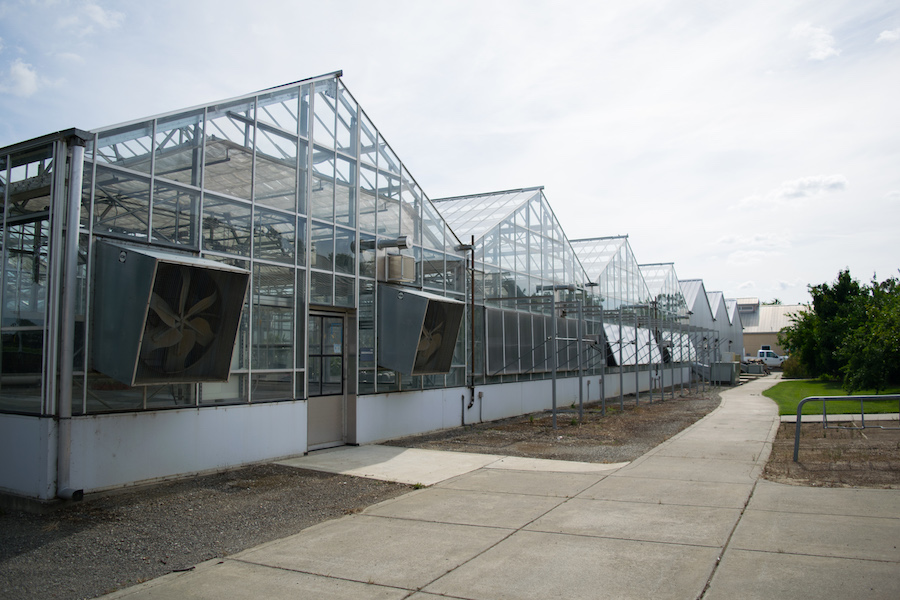
The Botanical Conservatory provides a place for students to learn, relax and observe plants.
You may have biked by them on your way to class or seen them glowing at the top of the Sciences Laboratory Building, but the greenhouses on campus are more than just your average plant-growing facilities.
The Science Laboratory Greenhouse is a production greenhouse for students to produce plants for class purposes only, while the Botanical Conservatory, off of Kleiber Hall Drive, provides a garden and museum to encourage an appreciation of botany in the community. The Botanical Conservatory houses about 2,500 different plant species from almost all of the planet’s climate zones and serves the Davis community as an educational and recreational facility.
“The Conservatory and the Greenhouses here are teaching support [facilities] for the campus,” said Ernesto Sandoval, manager of the Botanical Conservatory. “Our job is to grow plants for students to examine in classes, primarily in plant biology, so that they can see live plants as opposed to just pictures.”
Founded in 1959, the Botanical Conservatory offers free, self-guided tours to the public from 9 a.m. to 5 p.m. from Monday through Friday, as well as organized tours for UC Davis classes and elementary and middle school students. Despite the limited staff, Sandoval and those who help run the Conservatory strive to ensure that both UC Davis students and community members can enjoy its educational and aesthetic value.
“We are at a UC where students should be getting a top-notch education and seeing live specimens, which is something really important to students’ educational value,” Sandoval said. “At some other schools, students don’t always get to see live specimens. However, here at the College of Biological Sciences, we pride ourselves in providing as many live specimens as possible for students to observe freely.”
Hundreds of students in the Biological Sciences 2: Introduction to Biology (BIS 2) series come through the conservatory every quarter to examine particular plants and how they function. Another benefit of the greenhouses is that students can apply to be student employees and gain hands-on experience.
One of the student employees, Temme Von Lackum Dedlow, a fourth-year wildlife, fish and conservation biology major, first became intrigued with the greenhouse when she toured it as a BIS 2C student. Von Lackum Dedlow interned at the Conservatory last spring, and has worked as a student employee since the fall.
“I hope to go into biology with animals, not with plants, but I appreciate the work here for background experience and as a great time away from the average day of studying and staring at books and screens,” Von Lackum Dedlow said. “It’s a nice place to be, especially when I have a really busy class schedule, so three to four hour shifts every couple of days let my mind check out for a minute and allow me to get my hands in the soil.”
Another one of the classes that comes to the Conservatory is Plant Sciences 5: Plants for Garden, Orchard and Landscape (PLS 5), which focuses on gardening and landscaping. Before Sandoval leads the students through the greenhouses on the tours, he spends time introducing them to the different types of soils that the Conservatory uses and the importance of each one.
“Each week in PLS 5, we do things like plant crops, such as spinach, beans and bell peppers, and we also get to go on field trips to the Conservatory and vineyards,” said fourth-year neurobiology, physiology and behavior major Robyn Goldberg. “We went into the rainforest room first and saw the Spanish moss and the corpse flower [Titan arum], which is about 6 or 7 feet tall and is known to smell really bad. Ernesto gave a really entertaining and informative tour — I’ve never seen someone enjoy their job so much.”
The Botanical Conservatory features several different rooms, such as the rainforest and desert rooms, which house plant species native to those climate regions.
“Classes like PLS 5 at Davis are really cool because you get to bring home fresh produce that you grow yourself, and go to the greenhouses and observe plants that you wouldn’t normally see in your everyday travels,” Goldberg said. “You can read about what a waxy leaf or a large, segmented leaf looks like, but at the Conservatory, they can physically show you how it works and give you hands-on demonstrations of how each plant’s adaptations benefit them for survival.”
The Botanical Conservatory is another one of UC Davis’ hidden gems that introduces students to beautiful and exotic aspects of nature in the community, which is not something that every university can say for itself.
“Being able to look at a plant in three dimensions and see the adaptations on the leaf or physically touch its nectar is something that students can appreciate because that hands-on experience is a unique asset to have,” Von Lackum Dedlow said.
Written by: Gillian Allen — features@theaggie.org




